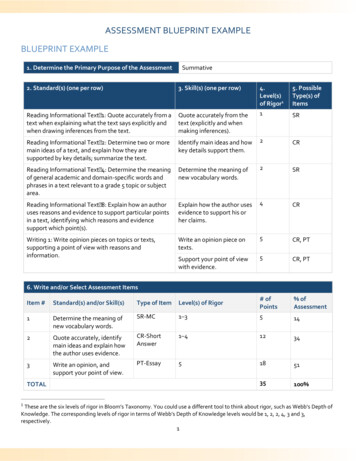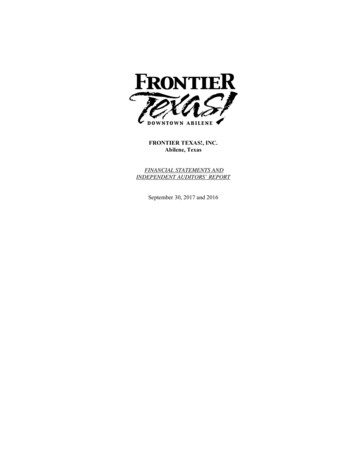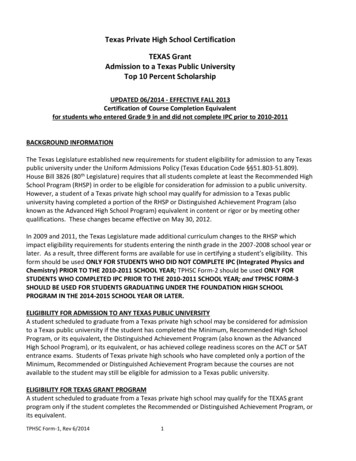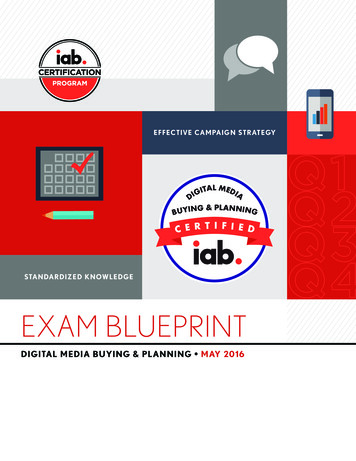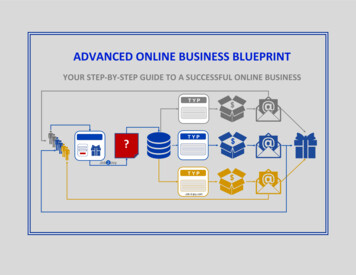
Transcription
P-TECH BlueprintBenchmark 1: School DesignThe P-TECH program must offer open enrollment and flexible scheduling structures that enable students to combine highschool, postsecondary courses and work-based learning, at no cost to participating students.Design ElementsAll P-TECHs must implement and meet the following requirements:1. The P-TECH location shall be:a. In a high school, ori.as a standalone high school campus orii.in a smaller learning community within a larger high schoolb. At a central location, such as a CTE Center where students are enrolled at their home campus, orc. On a college or university campus2. P-TECH staff shall include:a. A building level leader who has scheduling, hiring, and budget decisionsb. Industry/Business partner liaison with decision making authority who interacts directly and frequently (in person or virtually) with P-TECH leaderc. An Institute of Higher Education (IHE) liaison with decision making authority and interacts directly and frequently (in person or virtually) with P-TECHleaderd. Highly qualified P-TECH teachers who work directly with the students, which may include adjunct high school faculty capable of teaching collegelevel coursese. Counseling staff who support P-TECH students, including activities such as: coordinating with Institutions of Higher Education (IHE) for registration,monitoring of students’ high school and college transcripts, and monitoring high school and college courses to ensure all requirements are met3. The P-TECH shall establish a leadership team that includes high-level personnel from the school district, campus, industry/business partners, andIHE with decision-making authority who meet regularly and report to each organization. Regularly scheduled meetings must address the followingtopics:a. Identification of members and the role each member will play in the design, governance, operations, accountability, curriculum development,professional development, outreach, sustainability, and continuous monitoring and improvement of the P-TECHb. Share responsibility (between the school district, campus, industry/business partners, and IHE) for meeting annual outcomes-based measuresand providing annual reports to their respective boards as well as to the publicc. Monitoring of progress on meeting the Blueprint, including reviewing data to ensure the P-TECH is on-track to meet outcomes-basedmeasuresd. Mid-course corrections as needede. Sustainability structures to address and minimize the challenges of staff turnover and potential fluctuations in funding4. The leadership team shall include and meet regularly (in person and/or virtually) with the leaders from the school district, campus,business/industry, chambers of commerce, non-profit foundations, and IHE who have decision-making authority:District leaders (may include):a. Superintendent Texas Education Agency 20201
P-TECH BlueprintBenchmark 1: School DesignThe P-TECH program must offer open enrollment and flexible scheduling structures that enable students to combine highschool, postsecondary courses and work-based learning, at no cost to participating students.Design Elements5.6.7.8.9.b. Assistant superintendent of curriculum and instruction, or equivalent positionc. P-TECH principal or directord. CTE Director (if applicable to the P-TECH model)e. Department chairsf. School counselorsBusiness/Industry Partner (may include):a. CEO/Presidentb. Education/Community Outreach Specialist/Community Organizations such as a Chamber of Commerce and Non-Profit FoundationsIHE leaders (may include):a. College or university presidentb. Provostc. Department chairs for core academic disciplinesd. P-TECH liaisonImplement an annual professional development plan for teachers and staff, focused on research-based instructional strategies that focus on rigor,build college- and career-readiness, are based on needs assessment of student data, and includes both high school and dual credit teachers.Professional development may include, but is not limited to:a. A mentoring and induction program for newly hired staff, providing them with the instructional and interpersonal skills and capacities needed forsuccess in an advanced academic settingb. An externship program to expose teachers, counselors, and/or administrators to content in careers in the pathways identified by the P-TECHc. Opportunities for teachers to collaborate, plan and engage in relevant professional developmentProvide opportunities for P-TECH teachers to receive extensive training and support through regularly scheduled formative peer observations andcollaboration opportunities with feeder pattern focus groups, industry/business and/or IHE partnersThe P-TECH program shall provide flexible, individualized scheduling that allows students the opportunity to earn a high school diploma, industrycertifications, an associate degree, and engage in appropriate work-based learning at every grade levelThe P-TECH students shall be cohorted into core classes to the extent possible; this does not exclude non-P-TECH students from enrolling in the sameclassThe P-TECH program shall be offered at no cost to students Texas Education Agency 20202
P-TECH BlueprintRequired Activities and ProductsActivitiesa. All products shall be published on the P-TECH website and be made available to TEA upon requestb. All products shall be maintained in accordance with local retention policyProductsa. Mentor/induction program plansb. Annual training or professional development plan with P-TECH and IHE facultyc. P-TECH leadership meeting agendas and notes Texas Education Agency 20203
P-TECH BlueprintBenchmark 2: Target PopulationThe P-TECH program shall serve, or include plans to scale up to serve, students in Grades 9 through 14, and shall target and enroll studentswho are at risk of dropping out of school as defined by the Public Education Information Management System (PEIMS) and who might nototherwise go to college.Design ElementsAll P-TECHs must implement and meet the following requirements:1. The P-TECH shall be open enrollment for all students. Recruitment and enrollment processes shall identify, recruit, and enroll subpopulations of at-riskstudents (as defined by PEIMS), including, but not limited to, students who are of limited English proficiency, students with disabilities, or students whohave failed a state administered assessment. Enrollment decisions shall not be based on state assessment scores, discipline history, teacherrecommendation, parent or student essays, minimum grade point average (GPA), or other criteria that create barriers for student enrollment2. The P-TECH shall identify, recruit, and enroll subpopulations (in addition to those who are at risk as defined by PEIMS) that are historicallyunderrepresented in college courses3. The P-TECH shall clearly document recruitment and enrollment policies and practices; refining and improving them annually based on data reviews4. Recruitment and enrollment processes (including marketing and recruitment plans, materials, and timelines) shall be transparent in program requirements,and include input from key stakeholders (e.g., parents and community members; postsecondary partners); target student populations as described in 1 and2 above; and include regular activities to educate students, counselors, principals, parents, and school board and community members5. If the P-TECH has more applicants than available space for admissions, they shall use either a performance-blind, open-access lottery system thatencourages and considers applications from all students (all students have an equal opportunity for acceptance, regardless of background or academicperformance) or a weighted lottery that favors students who are at risk or who are part of the targeted subpopulations for the P-TECHRequired Activities and ProductsActivitiesa. All products shall be published on the P-TECH academy website and be made available to TEA upon requestb. All products shall be maintained in accordance with local retention policyProductsa. Written admission policy and enrollment applicationb. Written recruitment plan including a timeline of recruitment and enrollment events, and recruitment materials for distribution at feeder schools andother appropriate locations in the communityc. Brochures and marketing in Spanish, English, and/or other relevant language(s)d. Written communication plan for targeting identified audiences, parents, community members, school board, higher education personnel, etc. Texas Education Agency 20204
P-TECH BlueprintBenchmark 3: Strategic AlliancesStrategic partnerships with business and industry partners and IHEs are formally articulated in writing and clearly define avariety of careers.Design ElementsAll P-TECHs must implement and meet the following requirements based on the pathways to be offered to students i.e. pathways to an associate degree,postsecondary certificate provided by an IHE, or industry certification:1. The P-TECH shall develop, sign, and execute a memoranda of understanding (MOU) that clearly define the roles and responsibilities of a strongpartnership with business and/or industry partners to provide (at a minimum):a. A detailed plan for work-based learning experiences for students appropriate to each grade level, such as facility visits, guest speakers,presentations, career information, job shadowing, internships, externships, and apprenticeshipsb. Clear roles and responsibilities for worksite supervisors, mentors, teachers, support personnel, and other partnersc. Career mentoring with industry/business partnerd. Support for students’ activities, such as clubs, Career and Technical Student Organizations, competitions, and special initiativese. Each MOU must include an agreement that the regional industry or business partner will give to a student who receives work based training oreducation from the partner under the P-TECH program priority in interviewing for any jobs for which the student is qualified that are available onthe student’s completion of the programf. Course path and program monitoringg. The MOU should state clearly the industry certifications that will be acquired and the standards/curriculum that will be followed to achieve statedcertificationsh. Student access to business and industry partners and work-based learning facilities, services, and resourcesi. Transportation costs and fees2. The P-TECH shall develop, sign, and execute an articulation agreement with an IHE that includes the following components (at a minimum):a. Curriculum alignmentb. Instructional materialsc. Courses of study, which enables a student to combine high school courses and college-level courses to earn either an associate degreepostsecondary certificate provided by an IHE, or industry certificationd. Student enrollment and attendancee. Grading periods and policiesf. Administration of statewide assessments under TEC Subchapter B, Chapter 39g. Policies for:i.advising students on the transferability of all college credit offered and earnedii.ensuring the IHE transcripts college credit earned through dual credit in the same semester that credit is earned Texas Education Agency 20205
P-TECH BlueprintBenchmark 3: Strategic AlliancesStrategic partnerships with business and industry partners and IHEs are formally articulated in writing and clearly define avariety of careers.Design Elementsiii.advising students as to the transferability and applicability to baccalaureate degree plans for all college credit offered and earned (collegecredits earned during high school should allow students to progress from an associate degree to a bachelor’s degree and beyond in theirchosen field)iv.students accessing to the IHE facilities, services and resourcesh. Eligibility of students for waivers for tuition & feesi. Data sharing agreement that includes provisions for:i.Teacher data such as qualificationsii.Student level data such as credit hours taken and earned; GPA, formative data to assess if student is on track for college readinessj. Transportation costs and feesi.Provisions for discontinuing operation while ensuring students previously enrolled will have opportunity to complete their course ofstudy3. Establish an Advisory Board who meets regularly and includes representatives from a variety of stakeholders such as; school board, community,economic development partners, relevant industry subject matter experts for program pathways, and IHE to provide support and guidance to the PTECH in resource acquisition, curriculum development, work-based learning and student/community outreach to ensure a successful academic andcareer pipeline Texas Education Agency 20206
P-TECH BlueprintRequired Activities and ProductsActivitiesa. All products shall be published on the P-TECH website and be made available to TEA upon requestb. All products shall be maintained in accordance with local retention policyc. Annual review of industry/business MOUd. Annual review of IHE articulation agreementProductsa. Meeting agendas and minutes, with action items and decision logsb. Final, signed, and executed MOU with industry partner/business (Campuses must submit their final signed MOU to TEA when initially applying fordesignation or are provisionally designated)c. Final, signed, and executed articulation agreement with IHE (Campuses must submit their final signed MOU to TEA when initially applying fordesignation or are provisionally designated)d. A list of strategic partners with each member’s organization, title and role in providing work-based learning for students by grade level Texas Education Agency 20207
P-TECH BlueprintBenchmark 4: Curriculum, Instruction, and AssessmentThe P-TECH program shall provide a rigorous course of study that enables a participating student to receive a highschool diploma, an associate degree, postsecondary certificate provided by an IHE, or industry certification during Grades 914.Design ElementsAll P-TECHs must implement and meet the following requirements:1. The P-TECH shall work with the local workforce development board, local chamber of commerce, and local workforce industry representatives toidentify, create and maintain a list of high-demand occupations and programs of study that lead to these occupations to be used as a resource in creatingstructured pathways for students and updated as local needs change2. The P-TECH shall establish one or more career pathways, that include industry relevant classes, and plans are underway for sequencing additionalcourses for students. These course pathways are informed by regional and state workforce and economic development needs and contribute tostudents earning an associate degree, postsecondary certificate provided by an IHE, or industry certification that prepares them for high-wage, highdemand, high-skill career fields3. The P-TECH shall provide a course of study that enables participating students the opportunity to complete high school graduation requirements, andeither an associate degree, postsecondary certificate provided by an IHE, or industry certification on or before the sixth anniversary of the date of thestudent’s first day of high schoola. A course of study must be in place detailing how students will progress toward the goal of aligning high school, college-level courses, andindustry/business training. This course of study must provide pathways to an associate degree, postsecondary certificate provided by an IHE, or anindustry certification. The campus may implement a variety of instructional delivery models4. The P-TECH shall provide an assessment for measuring student progress to ensure students are on track to meet the Outcomes-Based Measures5. The P-TECH shall biannually implement a structured data review process designed to identify student strengths and weaknesses and develop individualinstructional support plansa. The P-TECH will establish annual assessment measures and provide an opportunity for the industry/business partners to provide feedback onthe value of the P-TECH program5. The P-TECH shall provide support for students taking courses preparing students to obtain industry certifications, licenses, etc.6. The P-TECH shall work with IHEs and business and industry partners to ensure curriculum alignment between high school, postsecondary and industryexperience requirements Texas Education Agency 20208
P-TECH BlueprintRequired Activities and ProductsActivitiesa. All products shall be published on the P-TECH website and be made available to TEA upon requestb. All products shall be maintained in accordance with local retention policyProductsa. Four-year crosswalk documentb. Master Schedulec. Curriculum alignment documentsd. Testing calendar and schedule for TSI, ACT, SAT or other assessmentse. Documentation detailing a minimum of three course of study examples that outline student pathways from high school, to associate degrees, to workcredentials and beyondk Texas Education Agency 20209
P-TECH BlueprintBenchmark 5: Work-Based LearningThe P-TECH program must offer students a variety of relevant, high-skill work-based learning experiences at everygrade level that respond to student interest and regional employer needs and contribute to students earning alignedindustry certifications and credentials.Design ElementsAll P-TECHs must implement and meet the following requirements:1. The P-TECH shall collaborate with the local workforce development board, local chamber of commerce, and local workforce industry representatives todefine local workforce needs2. The P-TECH shall have current, signed MOU with business/industry partners that are reviewed annually and clearly articulate the requirements outlinedin this benchmark. The MOU must include in the agreement that the regional industry or business partner will give a student who receives work-basedlearning first priority in interviewing for any jobs for which the student is qualified that are available upon the student’s completion of the program3. The P-TECH shall provide:a. Age level appropriate work-based learning for students in the P-TECH at every grade level that includes career awareness, career exploration,career preparation, and career experienceb. Policies and protocols to make work-based learning a viable method for helping students meet academic standardsc. Work based learning experiences that are well-planned and properly sequenced to provide a progression of learning experiences for students—each one building upon the lastd. Work based learning may include, but is not limited to: facility visits, guest speakers, presentations, career information, career fairs,informational interviewing, job shadowing, internships, mentoring, and apprenticeships4. The P-TECH shall ensure that students:a. Understand the connection between their work-based learning and academicsb. Are provided opportunities to reflect on their work experiencesc. Demonstrate their learning in writing, portfolio, presentation, digital or by other meansd. Are provided opportunities for career-building skills such as: interview training, skill development, and resume workshops5. The P-TECH shall allow for demonstration of enrichment and extracurricular opportunities, such as clubs, Career and Technical Student Organizations,competitions, and special initiatives Texas Education Agency 202010
P-TECH BlueprintRequired Activities and ProductsActivitiesa. All products shall be published on the P-TECH website and be made available to TEA upon requestb. All products shall be maintained in accordance with local retention policyProductsa. Documentation of appropriate work-based learning experiences for students at all grade levelsb. Current dated regional high demand occupation listc. Aggregate data describing student participation in work-based learning experiences as well as percentage of students earning industry certification andcredentials by typed. Samples of student artifacts such as writings, portfolios, presen
iii. advising students as to the transferabilit y and applic ability to baccalaureate degree plans for all college credit offered and earned (college credits earned during high school should allow students to progress from an associate degree to a bachelor’s
